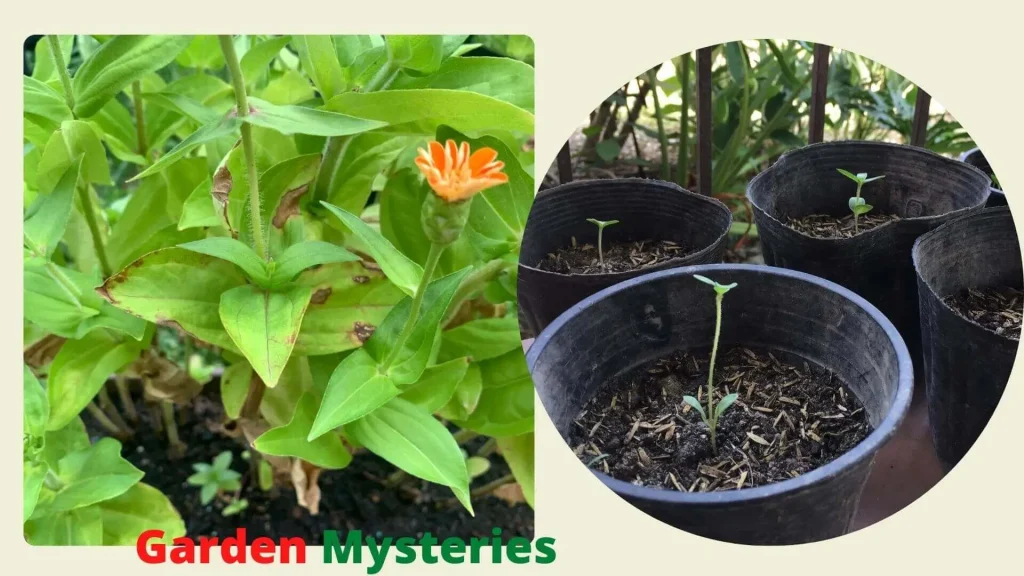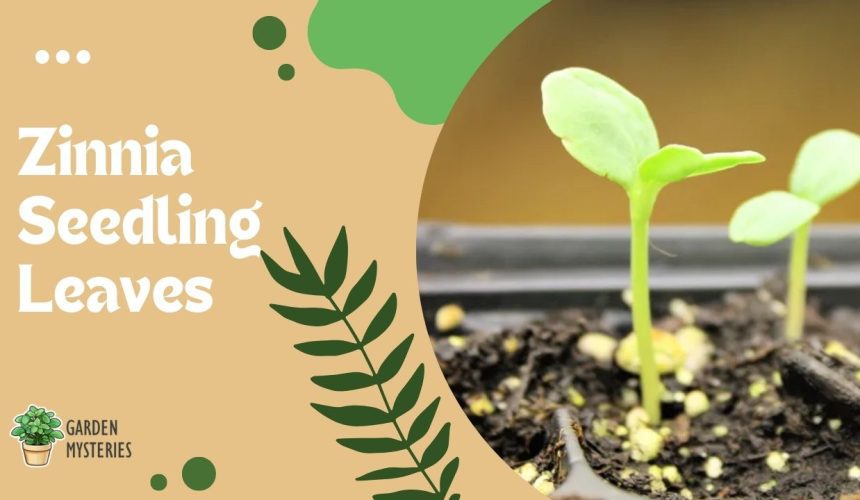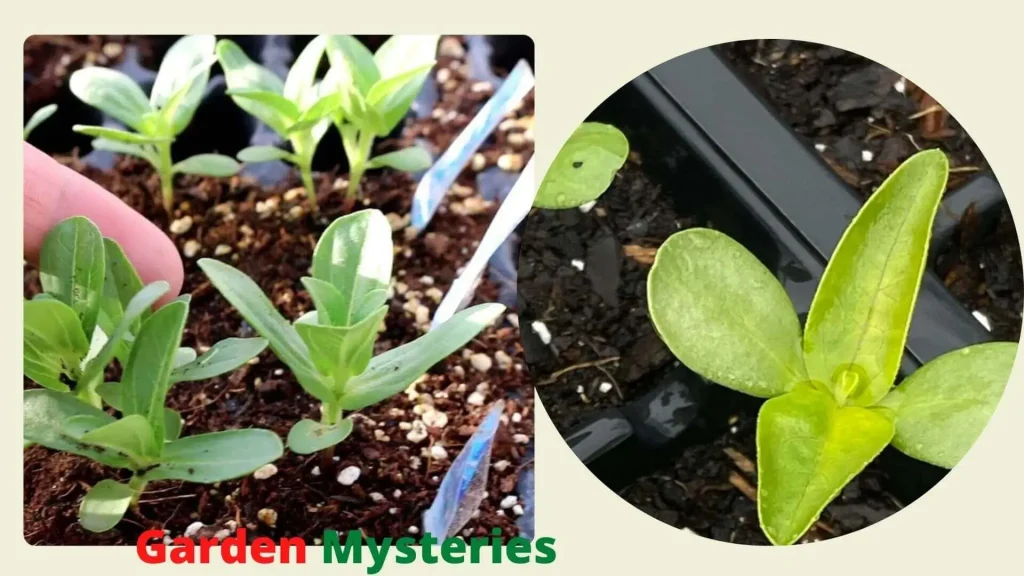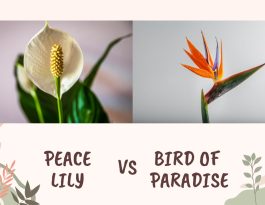A few days ago, I eagerly awaited my Zinnia seedling leaves to sprout in the garden. The funny thing was, I realized I didn’t know much about them. So, I decided to do some research and learn some interesting things.
It’s been quite an eye-opener from identifying these little leaves to understanding their growth stages and care tips. Let me share with you what I discovered about these charming green newcomers in my garden.
How do I Identify a Zinnia Seeding leaf?
To identify Zinnia seedling leaves is essential for successful gardening. But if you ask, How do I identify zinnia seedlings? Or, What do zinnia leaves look like? Here’s a step-by-step guide to help you recognize them:
- Arrangement: Leaves are arranged oppositely on the stem, growing in pairs directly across from each other.
- Shape: Early-stage leaves are oval or lance-shaped with a pointed tip.
- Texture: The surface is smooth, often with a slightly glossy appearance, and tender to the touch.
- Color: Initial leaves are pale green, darkening to a richer green as they mature.
- Veins: Prominent veins are slightly raised and visible.
- Size: Smaller than mature leaves, usually a few centimeters in length, varying by Zinnia variety.
By keeping these characteristics in mind, you can easily identify Zinnia seedling leaves during the first few weeks after germination.
How To Grow Zinnia seedlings?
Growing Zinnia seedlings is a rewarding and straightforward process. You should follow these six easy steps to enjoy vibrant Zinnias in your garden:
Step 1: Seed Selection and Timing
Choose high-quality Zinnia seeds from a reliable source. Start your seedlings indoors 6 to 8 weeks before the last expected frost date in your area, typically in early spring.
Step 2: Planting and Soil Preparation
Use clean seed trays or small pots with drainage holes. Fill them with a well-draining potting mix made of equal parts compost and perlite or vermiculite. This ensures good aeration and moisture retention.
Step 3: Sowing and Watering
Plant Zinnia seeds about 1/4 inch deep and space them 2 inches apart. Moisten the soil evenly after sowing. Thus it will keep it consistently damp but not waterlogged.
Step 4: Light and Temperature
You should place the trays or pots in a location with bright, indirect sunlight. Maintain a temperature between 70°F to 80°F (21°C to 27°C) for optimal growth, using a heat mat if necessary.
Step 5: Germination and Thinning
Zinnia seedlings typically emerge within 5 to 10 days. Once they have at least two sets of true leaves, thin them to leave about 6 inches of space between each seedling.
Step 6: Transplanting and Outdoor Care
When the risk of frost has passed and seedlings are 3-4 inches tall, transplant them outdoors, spacing them 8-12 inches apart in well-drained soil. You must ensure full sun exposure, keep the soil moist, and mulch around the plants to retain moisture and suppress weeds. Pinch off spent flowers to encourage more blooms.

How Long Do Zinnia Seedlings Take to Sprout?
Zinnia seedlings typically sprout within 7 to 10 days after planting, provided they are kept in optimal conditions. These conditions include well-draining soil, consistent moisture, and a warm environment with temperatures around 70-75°F (21-24°C).
Some varieties may emerge slightly earlier or later, but a week to ten days is a reasonable expectation. It’s essential to maintain patience and ensure proper care during this critical germination period to encourage healthy and robust growth.
Once sprouted, Zinnia seedlings will begin their journey toward vibrant and colorful blooms, making the waiting period well worth it for any garden enthusiast. So, now you have the answer to How long does it take for zinnias to sprout.
Besides Zinnia, Orchids are also a great addition as indoor flower plants. I have a bunch of orchid-related articles. For example, whether lava rock is good for your orchid or not. You will find the solution here.
What Should I Do If My Zinnia Seedlings Are Not Growing Properly?
If your Zinnia seedlings are not growing properly, it’s important to diagnose the issue and take corrective measures. Follow these steps to address common problems:
Step 1: Check Environmental Conditions
Try to ensure your seedlings get enough sunlight. Zinnias need full sun, so move them to a sunnier spot or use artificial light if needed. Keep the temperature between 70°F to 80°F (21°C to 27°C); use a heating mat if it’s too cold.
Step 2: Review Watering Practices
Avoid overwatering, which can cause root rot and stunted growth. Keep the soil moist but not waterlogged, allowing the top inch to dry slightly before watering again. Use well-draining potting mix and containers with drainage holes.
Step 3: Assess Soil Quality
You can use a high-quality potting mix with good aeration and drainage. Zinnias prefer slightly acidic to neutral soil (pH 6.0 to 7.0). Add a slow-release balanced fertilizer if the potting mix lacks nutrients.
Step 4: Thin Seedlings
Overcrowded seedlings compete for resources and grow poorly. Thin them to provide adequate spacing, usually about 6 inches apart, to ensure they have enough room to grow.
Step 5: Control Pests and Diseases
You can check for pests like aphids and caterpillars and for diseases like fungal infections. Use organic pest control methods or appropriate fungicides to treat any issues promptly.
Step 6: Ensure Adequate Air Circulation
Good air circulation prevents disease development. Use a small fan indoors to improve air movement around your seedlings, reducing the risk of fungal infections and promoting healthy growth.

When to Transplant Zinnia Seedlings?
Transplanting Zinnia seedlings is a critical step in their growth journey. It’s best done when the risk of frost has passed and the seedlings are well-established, typically when they reach a height of 3 to 4 inches and have developed at least two sets of true leaves.
This usually occurs after 4 to 6 weeks of indoor growth following germination. In most regions, this translates to late spring or early summer, when the weather is consistently warm and there’s no danger of cold temperatures harming the young plants.
Make sure the soil outdoors has also warmed up adequately. When transplanting, choose a sunny location with well-drained soil and space the seedlings about 8 to 12 inches apart, depending on the Zinnia variety.
You should provide adequate spacing, which allows for proper air circulation and helps prevent disease. Proper timing and care during transplanting contribute to the success and health of your Zinnia plants. So, they can continue to grow and flourish in their new outdoor home.
Common Diseases and Solutions for Zinnia Seedlings
| Disease | Symptoms | Solution |
|---|---|---|
| Powdery Mildew | White, powdery spots on leaves | Improve air circulation, avoid overhead watering, and apply fungicide if needed. |
| Downy Mildew | Yellow spots on leaves, white fuzz below | Ensure good air circulation, keep foliage dry, and use appropriate fungicides. |
| Root Rot | Wilting, yellowing, and mushy roots | Improve drainage, reduce watering, and use a well-draining potting mix. |
| Leaf Spot | Brown or black spots on leaves | Remove affected leaves, improve air circulation, and apply a fungicide. |
| Botrytis Blight | Gray mold on flowers and leaves | Remove and destroy affected parts, avoid overhead watering, and ensure good air circulation. |
| Damping Off | Seedlings collapse and die | Use sterilized soil, avoid overwatering, and ensure proper drainage. |
| Aphid Infestation | Yellow, distorted leaves with sticky residue | Spray with insecticidal soap or neem oil, and introduce beneficial insects like ladybugs. |
FAQs
What should I do if Zinnia seedling leaves turn yellow or brown?
Yellow or brown Zinnia seedling leaves may indicate issues like overwatering, nutrient deficiencies, or pests. You should address the underlying problem to restore their health.
Can I prune Zinnia seedling leaves for better growth?
It’s generally not recommended to prune Zinnia seedling leaves. They play an important role in early growth, and pruning may hinder their development.
When do Zinnia seedling leaves transition into mature leaves?
Zinnia seedling leaves gradually transform into mature leaves as the plant matures, usually within a few weeks to a month after germination.
Have you thought about which fertilizer you will use? You will get to know about Earthbox Replant Kit Alternative here.






